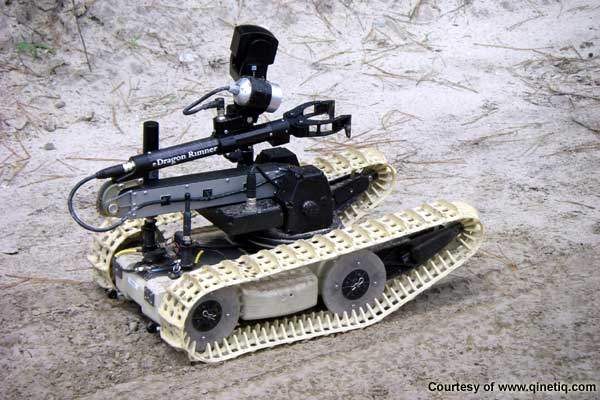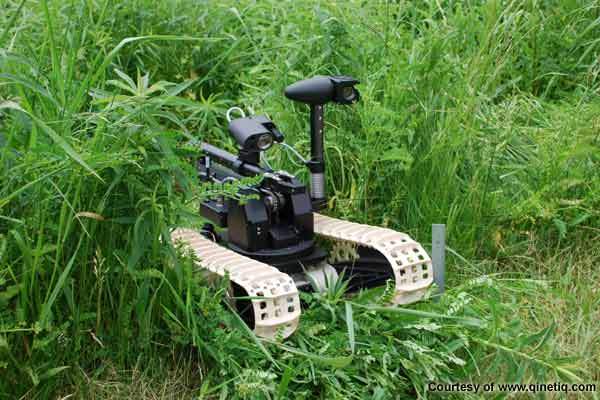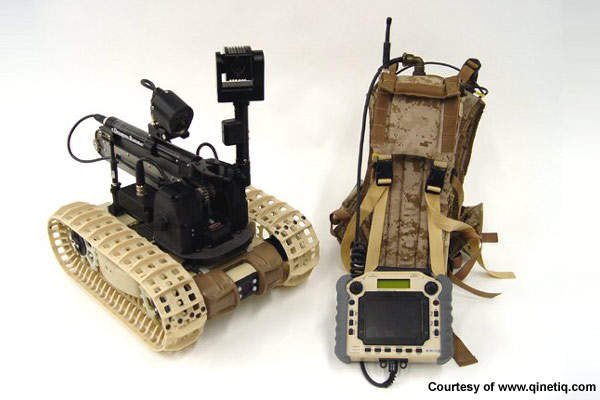The Dragon Runner is a rugged, ultra-compact, lightweight and portable reconnaissance robot developed for urban operations (UO). The prototype model of the Dragon Runner measures around 23cm in length, 20cm wide and 7.5cm tall with a weight of about 14lbs. The basic robot operates as a tough, low-observable ground sensor providing corner views to users moving at a speed of about 5mph.
The Dragon Runner was originally developed by the National Robotics Engineering Centre (NREC), part of Carnegie Mellon University, in collaboration with Automatika, under a contract with the US Marine Corps during 2002-03. The robot was for use by the US Marine Corps during the Operation Iraqi Freedom (OIF) and a dozen were deployed for sentry missions and the urban reconnaissance. In May 2007, Automatika was acquired by Foster-Miller, a QinetiQ North America company. QinetiQ made the Dragon Runner commercial.
Dragon Runner reconnaissance robot design
The Dragon Runner is so robust that it can be thrown over fences, moving vehicles, up or down stairwells, or from a three-storey building. It is built to function in either of the directions it lands, and can also reach destinations on its own power.
Powered by military batteries, the Dragon Runner is very rugged, enabling its usage in dangerous urban warfare areas and army troop inaccessible environments. The robot makes use of small-scale hand controllers and can be carried in a custom mission backpack.
Dragon Runner SUGV mission variants
In September 2008 QinetiQ developed and launched the enhanced variant of the Dragon Runner designed as a small unmanned ground vehicle (SUGV). The modular robot system is capable of reconnaissance and also serves as the improvised explosive device (IED) disarmament in rural, mountainous and urban environments.
The SUGV has a manipulator arm, with a rotating shoulder, wrist and grippers for dexterity, and can lift weights of up to 10lb. The lightweight robot can also climb stairs and open doors to fit into a mission.
The modular design enhancements allow the field personnel to add a different combination of flippers, treads, sensors, cameras and other arms to the robot. The Dragon Runner SUGV operators can also add or change tracks to increase the mobility.
The applications of the enhanced robot include reconnaissance inside buildings, courtyards, caves, sewers and drainpipes. It can be used for ensuring perimeter security by applying on-board motion and sound detectors; for checkpoint security; interior inspection of a bus, train or planes; and under-vehicles inspection. It can also be used for hostage barricade reconnaissance and negotiation.
Dragon Runner robot features
The Dragon Runner’s surveillance and reconnaissance can be made more efficient through a 40:1 pan, tilt and zoom camera mounted on a power mast, listening devices and motion detectors. The robot is also equipped with infrared for night vision. The long-range RF operating capacity enables its operation in jammed environments.
The Dragon Runner robot has six cameras, four passive infrared motion detectors and is audio capable. The four sturdy-wheeled Dragon Runner under the mobile robotics platform is portable and operated by a small wireless remote operator control system (OCS).
Dragon Runner robot communications
The Dragon Runner is controlled by a soldier from a safe distance, who can visualise the situation and direct its movement, through the robot’s onboard colour video cameras. The camera gives real-time images of the operating conditions instantly to the control centre.
A CPU on the vehicle is interfaced with the operator control unit (OCU) through a wireless modem transceiver, which allows the communicational exchange. It can be operated in three different modes, namely drive mode, watch mode and sentry mode, where it can detect motion from about 30ft using sensors and microphone.
The Dragon Runner’s configuration can be easily changed to adopt to various communication systems. It has both analogue and digital communication radio configuration options which enable field-changeable frequency capabilities, improves the range and flexibility.
Dragon Runner orders and deliveries
In August 2009, Mesa, Arizona Police Department took delivery of the Dragon Runner robot built with special equipment to deal with the problems encountered by the police SWAT teams.
In November 2009, QinetiQ received contracts for around 100 Dragon Runner robots from the UK Ministry of Defence (MoD) to support its military operations in Afghanistan. The value of the contract was £12m ($19m) and includes the provision of technical services and spares.







